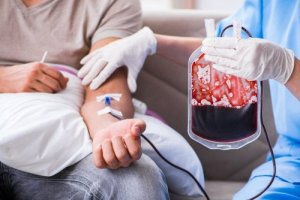Blood Transfusions - Purpose and Procedure


Written and verified by the doctor Leonardo Biolatto
Blood transfusions are one of the pillars of current medicine because the procedure saves many lives by replacing the blood a person may have lost due to an injury.
The first blood transfusions that we know about happened in the 17th century. However, it wasn’t until the twentieth century that scientists identified different types of blood groups. Thus, until then, transfusions could prove to be life-threatening.
The blood group is a classification of blood according to the characteristics of the red blood cells and their serum. When a person gets blood from a group that’s not their own, incompatibility reactions occur and they could lead to death.
This idea was key in the development of blood transfusions and now makes them a safe and effective procedure. In today’s article, we’ll tell you everything you need to know about it.
Blood transfusions – the procedure
Blood transfusions are a routine procedure in medicine. They consist of a patient receiving blood, or some of its derivatives, from another person. So, the blood contains the following elements:
- Red blood cells, which are responsible for transporting oxygen and help to eliminate waste
- White blood cells, which help the body fight infections
- Platelets, which are involved in blood clotting
- Plasma, the liquid part
In order to do a blood transfusion, a person must first donate blood. A donor is, of course, a volunteer who doesn’t receive any kind of remuneration for giving blood.
Check out: The Myths and Truth about Blood Donation
Procedure for donating blood
Donation is a very simple procedure that can help save a person’s life. To be a donor, you need to be in good health, weigh more than 110 pounds and not be anemic or have other blood problems.
To donate blood you must go to a specialized center or take advantage of different health campaigns. These usually take place in public places, such as schools, universities and town halls.
Once there, you’ll sit with your arm extended on an armrest. The person in charge will measure your blood pressure and make sure you’re in optimal condition to donate. Then, they’ll tie a tourniquet around your arm.
Once the tourniquet is in place, the lab technician will easily find the proper vein and insert a needle into it. The needle must be sterile, and they should also clean your skin before inserting it. Once you’ve been punctured by the needle, the blood will fill a bag of about 16 oz.
The procedure is simpler than it seems and it’s also painless. It should last about ten minutes. Then the lab technician will provide you with a small snack so you can recover. This procedure seldom leads to complications.
Some studies claim that people donate about 92 million units of blood each year. However, there’s still a deficit of 22 million units worldwide. Therefore, we should all be encouraged to be donors.
You might like 5 Important Reasons to Know Your Family Members’ Blood Types
What’s the purpose of blood transfusions?
Blood transfusions are used for treating patients with deficits in any of their blood components. For example, those with a deficiency in their bone marrow and cannot generate blood cells.
Doctors use this procedure in the treatment of hemophilia to ensure that these patients can carry out the coagulation process properly. Other uses are:
- After hemorrhages, to replenish the blood volume
- Major surgeries where you can lose a lot of blood, such as organ transplants and injury repair
- Chronic anemia
- Patients undergoing chemotherapy
What are the risks of this procedure?
Generally, blood transfusion is a safe procedure. However, complications can also occur even if the risk is low. The most common are mild allergic reactions, which cause hives and fever.
Similarly, you must know that it could lead to infections even when lab technicians already test donor blood to rule out any communicable infections such as HIV or hepatitis.
Unfortunately, some transfusions lead to immune reactions. This is because the immune system attacks foreign transfused red blood cells.
Conclusion
Blood transfusion is a procedure that can save the lives of many people. Because of that, it’s important to be aware that all healthy people can be donors. After all, it could be you who needs the blood of a donor someday.
All cited sources were thoroughly reviewed by our team to ensure their quality, reliability, currency, and validity. The bibliography of this article was considered reliable and of academic or scientific accuracy.
- OMS | Transfusión de sangre. (2016). WHO. Retrieved from https://www.who.int/topics/blood_transfusion/es/
- Indicaciones para la transfusión | Centro Regional de Transfusión Sanguínea de Granada y Almería. (n.d.). Retrieved August 28, 2019, from http://transfusion.granada-almeria.org/actividad/indicaciones-para-la-transfusion
- Melians Abreu, S. M., Núñez López, E., Esquivel Hernández, M., & Padrino González, M. (2017). Revista de ciencias médicas de Pinar del Río (Vol. 21). Editorial Ciencias Médicas. Retrieved from http://scielo.sld.cu/scielo.php?script=sci_arttext&pid=S1561-31942017000100005
- Información básica para donantes – Centro de Donación de Sangre de Cruz Roja. (n.d.). Retrieved August 28, 2019, from http://www.donarsangre.org/informacion-basica-para-donantes/
This text is provided for informational purposes only and does not replace consultation with a professional. If in doubt, consult your specialist.








